Canon 5D Mark III vs Nikon D800
Full-frame DSLRs go head to head
Screen performance
Canon and Nikon have been equally generous with the size of the screens on the cameras, and both have a 3.2-inch unit. However, with a resolution of 1,040,000 dots, the 5D Mark III's monitor trumps the 921,000-dot device on the D800. The gap between the panel and the glass cover is filled with an optical resin in both screens, and this helps to limit reflections.
Although we found that the Canon screen does a particularly good job of controlling reflections, subjects appear marginally sharper in the D800's screen when using it to aid manual focus. However, this isn't entirely down to the screen - the higher-resolution images don't need enlarging quite so much on-screen to make the subject a comfortable size for focusing.
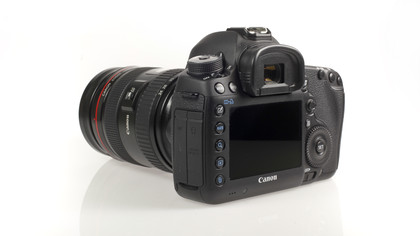
It isn't a major issue, but when shooting an identical composition we found that we were usually able to achieve manual focus more quickly and with fewer back and forth adjustments with the D800 than with the 5D Mark III.
There have been a few reports of the D800's screen having a slight green cast, and it's something we observed on a few occasions during the course of this test. We found it was an issue when there was a slight green note to the image, and the screen appears to enhance or over-saturate the green, creating an obvious cast.
Metering on test
As you would expect from two high-end cameras, the Canon EOS 5D Mark III's and Nikon D800's metering systems can cope with most situations, but neither is entirely foolproof.
The D800's 3D Colour Matrix Metering III system, which uses a 91,000 pixel RGB sensor that informs the scene recognition system, for example, appears to be prone to slightly over-exposing scenes on occasion for no obvious reason. When photographing a cyclist peddling along a road on a bright but overcast day, for example, we had to reduce the exposure by 2/3EV during part of the shoot.
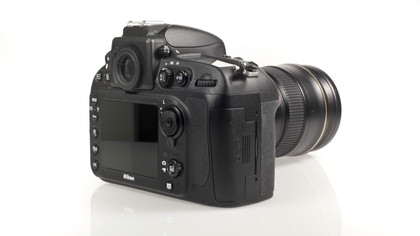
As this scene contained a face (although quite distant in some shots) it is possible that the exposure resulted from the 3D Colour Matrix Metering III's face detection system exposing for the face. In reflex mode the face detection system doesn't influence the focusing system, just the exposure and there is no indication of whether the camera has detected a face or not.
Sign up for breaking news, reviews, opinion, top tech deals, and more.
Most of the occasional exposure errors introduced by the Canon 5D Mark III's iFCL metering can usually be attributed to the fact that it gives weighting to the subject under the active AF point, and if it is considerably brighter or darker than a midtone, the image may be under or over-exposed accordingly. Neither of these problems is a major issue and they don't arise that often, but they are worth bearing in mind, especially at the start of a long shooting sequence.
Focus on autofocus
With 61 individually selectable points, of which 41 are cross-type, the 5D Mark III's AF system would seem, on paper at least, to be a little ahead of the D800's, which has 51 points (15 cross-type). In use, however, the extra 10 aren't that noticeable, and both cameras prove adept at keeping up with moving subjects even in quite low light.
Those upgrading from an APS-C format camera, or who use a compact system camera, will notice that both these full-frame DSLRs suffer from the fact that all the AF points are clustered around the centre of the frame, with none towards the edges. This is annoying when shooting subjects that are far off-centre.
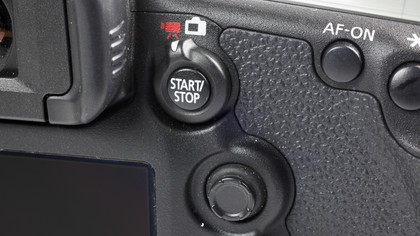
One advantage that the D800's Multi-Cam 3500 FX autofocus system has over the 5D Mark III's is that the central 11 AF points are sensitive down to f/8. This means that it is still possible to focus automatically when using lens and teleconverter arrangements that have a maximum effective aperture of f/8.
A 200-400mm f/4 lens mounted via a 2x teleconverter, for example, effectively becomes a 400-800mm f/8 lens. If this were mounted on the Canon EOS 5D Mark III, the autofocus system would be unable to function properly, but the D800's would soldier on. This is especially useful for wildlife photographers wishing to avoid the expense and weight of very long telephoto lenses.
The autofocus system inside the 5D Mark III is a serious upgrade on the one in the Mark II, and Canon has given the new camera a dedicated menu screen to accommodate the newly introduced options.
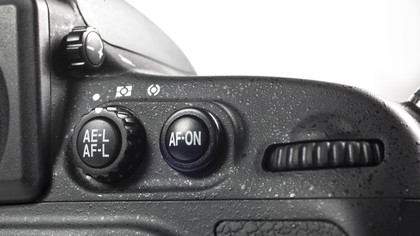
However, the option to adjust tracking sensitivity and acceleration/deceleration tracking adds a new layer of complication, and to simplify matters Canon has included a number of 'Cases' that set up the camera's AF system to respond in a particular way. While these help, they also take a little fathoming out themselves.
The AF system in the D800 is similarly complex, and there are no example cases, but the language used in the menu is a little more straightforward to understand.
White balance and colour
While both cameras produce images with pleasant colours in most natural light conditions when their automatic white balance systems are used, the Canon EOS 5D Mark III leans towards warm tones while the Nikon D800 seems to favour cool notes. Naturally, these small shifts appear more dramatic when images from each of the two cameras are compared side-by-side.
Colours are generally handled well at the lower sensitivity settings, but at very high sensitivity values in low light, both cameras are prone to losing some tonal gradation, especially with red subjects.
Noise and detail
Thanks to its 36.3 million pixel sensor, the D800 is able to resolve an incredible amount of detail. In fact, our resolution chart tests show that it doesn't fall too far short of the medium-format Pentax 645D, which has a 44 x 33mm sensor with 40 million pixels. While the 5D Mark III can't quite compete with such class-leading resolution, it nevertheless records a lot of detail.
Because it has such a high pixel count, we might reasonably expect the D800 to produce images that suffer from high levels of noise a little earlier in the sensitivity range than the 5D Mark III. While this is generally true, Nikon has done a remarkably good job of controlling the problem. Scrutinising images from the two cameras reveals that the story is quite complex, with aspects such as light level and colour temperature making a difference to the final results.
Even when the sensitivity levels are pushed up as far as ISO 6400, images taken in decent light still look very good. However, when light levels fall, chroma noise becomes more of an issue, especially in the shadows. Low-light images taken at the 5D Mark III's maximum extension setting (ISO 102400) look especially soft and smudgy.
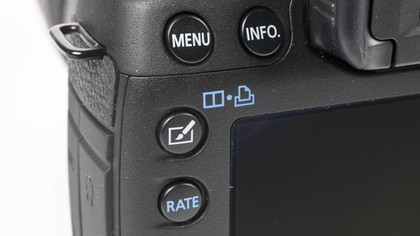
Comparing JPEG images captured with the two cameras at ISO 25600 with their high-ISO noise reduction system set to their default 'Normal' or 'Standard' values reveals that the D800 generally records more chroma noise.
However, the shots from the Canon camera are slightly smoother and have very slightly less detail visible when they are scrutinised at 100%. Even when the magnification of the D800's image is reduced so that it matches the size of the 5D Mark III images at 100%, more noise is visible in the Nikon camera's shot.
When the in-camera noise reduction is turned off, or its effects on raw files are removed post-capture, high-sensitivity images from the two cameras look quite different at 100%. While the 5D Mark III's images have a strong hatched texture, comparable images from the D800 suffer from more noticeable chroma noise.
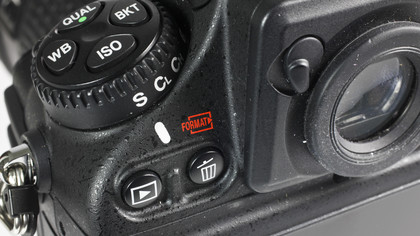
At more sensible printing sizes, however, both cameras are capable of producing decent results, and ISO 25600 images look OK at A3 (11.69 × 16.54 inches) size.
Apart from the difference in size and detail resulting from the higher pixel count of the D800, images captured at ISO 6400 and below by the two cameras look fairly similar on screen. At high magnification, some areas may be captured better by one camera than the other, and vice versa.
As we might expect, most detail is captured in raw files and the best results are created when the noise reduction level is tailored to each image. Nikon D800 users will find that the supplied software, View NX 2, is sadly lacking in this department, and they must invest in Capture NX 2 or use the latest incarnation of Adobe Camera Raw to adjust noise reduction post-capture.
Video features
Even Canon was surprised by the success of the 5D Mark II's video functionality. It gave keen film makers a high-quality HD video camera at a fraction of the cost of normal broadcast quality models. As a result, it has been used to shoot blockbuster Hollywood films, popular TV shows and news reports, as well as a fair bit of amateur footage.
Naturally, Canon is eager to build on this success with the 5D Mark III, and Nikon wants to carve itself a slice of the market. On the whole the video specification of the 5D Mark III is the same as the Mark II, but (as with the D800) there's a headphone port to enable better sound quality monitoring, and the sound level can be adjusted in-camera.
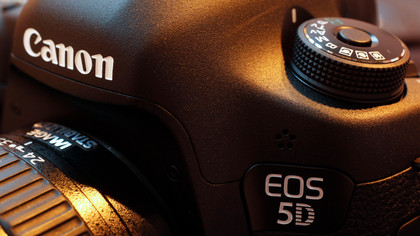
One advantage that the Nikon D800 offers over the Canon 5D Mark III is its ability to shoot with multiple frame sizes for different focal length and depth of field effects. There's also a 60p/50p 1280x720 slow-motion mode and clean, uncompressed HDMI output.
Performance-wise, neither camera disappoints and the two produce high-quality footage. As with the stills, the 5D Mark III tends to produce warmer videos than the cooler output from the D800, and noise is more of an issue for the Nikon camera as light levels fall and sensitivity levels rise. Sound quality is also decent, although an external mic is recommended.